
Mazda CX-5 2022 review
Mazda's CX-5 has undergone a little nip and tuck for the 2022 model year, but is that enough to keep up with Toyota RAV4, Subaru Forester and Kia Sportage? We put the new model to the test to find out.
Browse over 9,000 car reviews
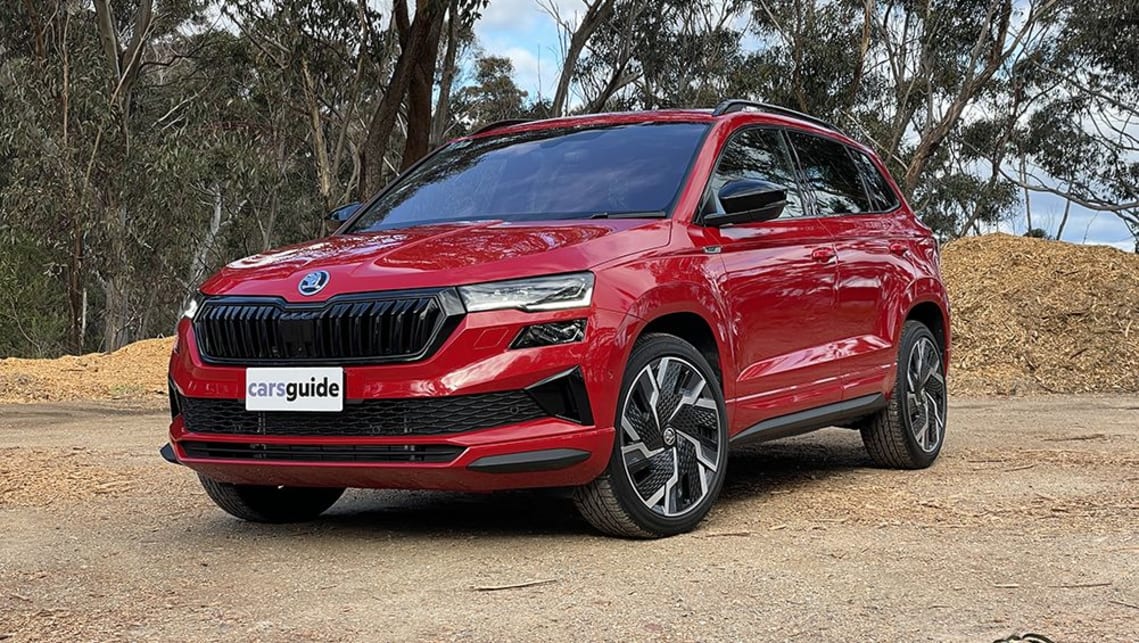
It’s easy to forget about the Skoda Karoq. It’s not that it’s a particularly forgettable model - it’s really not - it’s more that people just don’t know it exists.
That might be due to the fact that Skoda Australia did not do any promotional or marketing activities for the Karoq when it arrived back in 2018, because, at the time, it didn’t have adequate supply.
The company didn’t want to over-promise and under-deliver given the lack of available stock.
From 2020, the global pandemic has made the supply situation even worse so the Karoq has remained something of a hidden gem in the segment.
This mid-life facelift and slowly improving supply could ensure the Karoq gets a little more attention, but fighting for the limelight against the likes of the Toyota RAV4, Mazda CX-5, new Nissan X-Trail, not to mention its Volkswagen Tiguan sibling, could prove challenging.
Does the Karoq deserve to be added to more shopping lists for buyers looking for a mid-size family SUV?
| Skoda Karoq 2023: Style 110TSI | |
|---|---|
| Safety rating | |
| Engine Type | 1.4L turbo |
| Fuel Type | — |
| Fuel Efficiency | 6.5L/100km |
| Seating | 5 seats |
| Price from | $38,390 |
The updated Karoq comes with more standard gear compared with the model it replaces, and a price increase.
As with the pre-facelifted model, the Karoq is available in just two model grades. The range kicks off with the front-wheel drive 110TSI Style priced at $42,990 drive-away, while the flagship remains the all-wheel drive 140TSI Sportline 4x4 at $49,990. Both variants are $3000 more expensive than before.
Skoda Australia says the updated Karoq 110TSI Style includes about $4500 worth of extra gear over its predecessor, which represents $1500 of better value when taking into account the price increase.
Some of the new standard kit includes 18-inch alloy wheels (up from 17s), LED headlights, front parking sensors (it already had rear sensors), a hands-free power tailgate, power-folding and heated exterior mirrors, a rear spoiler, extended pedestrian protection for the autonomous emergency braking system, driving profile selection, digital radio, wireless phone charging and luggage nets.
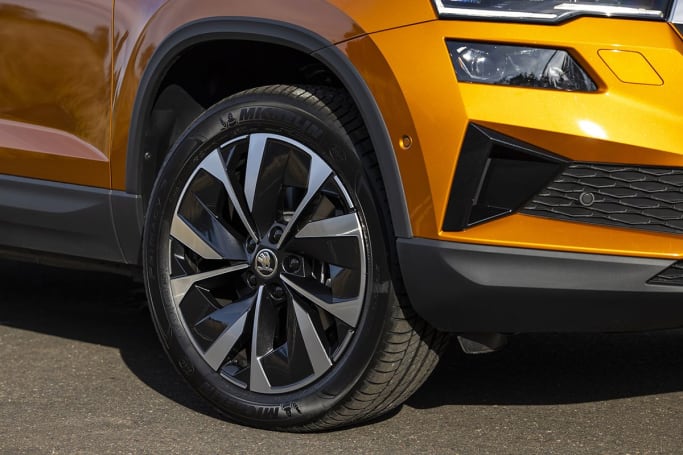
Other standard gear includes rain-sensing wipers, keyless entry and start, dual-zone climate control, ‘virtual cockpit’ digital instrument cluster, 8.0-inch multimedia screen with wired and wireless Apple CarPlay and Android Auto.
You can option the Style grade with a panoramic sunroof ($1900), side steps ($1200), a 'Tech Pack' ($5900) that adds a larger 9.2-inch central screen with gesture control, Matrix LED headlights, auto parking, lane assist, traffic jam assist and more, or a 'Premium Pack' ($10,900) that includes leather-appointed seats, power front seats, front and rear heated seats, a heated steering wheel, and more.
Stepping up to the Sportline 4x4 will net you sports seats throughout, larger 19-inch alloy wheels, Matrix LED headlights, fog lights, a black body kit, stainless steel pedal covers, a sports steering wheel and of course, a beefier turbocharged engine.
The additions to the Sportline amount to $4100, making for $1100 of extra value, according to Skoda’s calculations.
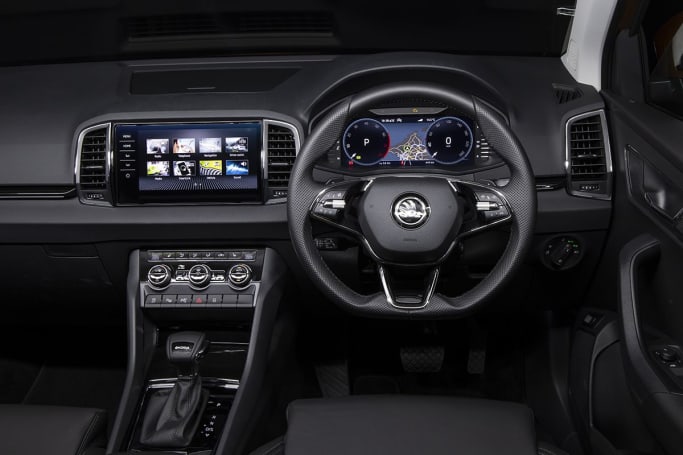
The Sportline can also be optioned with packs including a 'Leather Seats Pack' ($3200) and 'Premium Pack' ($5900).
Skoda’s pricing puts the 110TSI Style in the crosshairs of other medium SUVs like the Mazda CX-5 Maxx Sport ($40,690, before on-road costs) or the Kia Sportage 2.0 SX+ ($41,500, BOC).
The Sportline lines up against the Toyota RAV4 Edge petrol AWD ($50,200, BOC) and the mechanically related Volkswagen Tiguan 132TSI Life AWD ($46,690, BOC).
The Skoda’s standard features list could be described as generous without being over the top. While it outpaces a few rivals for tech and in-car features, it lacks some of the safety gear standard on those models. More on that in a bit.

The changes Skoda has made to the Karoq’s design as part of the mid-life update are best described as subtle.
It gains a new front bumper and wider lower air intake, new headlight design, and split daytime running lights, as well as an extended tailgate spoiler and redesigned slimline tail-lights at the rear, capped off by new alloy wheel designs.
The Karoq is probably the most conservative looking Skoda you can buy, and while the refresh has certainly sharpened up the SUV’s design, it hasn’t elevated it.
Compared with the modern exterior design of rivals like the Hyundai Tucson and Kia Sportage twins, the upcoming new-gen Nissan X-Trail or even the Peugeot 3008, the Karoq looks a little too conventional.
In saying that, fans of understated design will likely appreciate Skoda’s measured approach.
Very little has changed inside and the interior design is functional, but somewhat generic.
As Skoda points out, the Karoq has smaller exterior dimensions than rivals like the Mazda CX-5, Kia Sportage and Honda CR-V, but, for the most part, it has more interior occupant space in the front and rear rows, and more luggage space, than those models.
That’s down to clever packaging - something Skoda does very well.
In the 110TSI Style, the Karoq has excellent storage in the front doors for tall and wide drink bottles, as well as extra space in the door cavity for the useful Skoda rubbish bin.
There’s a handy storage compartment with a lid on the top of the dash, while the central storage bin can be covered by moving the armrest back or forth. It has a wireless charging pad with a sliding cover and a pair of USB-C ports.
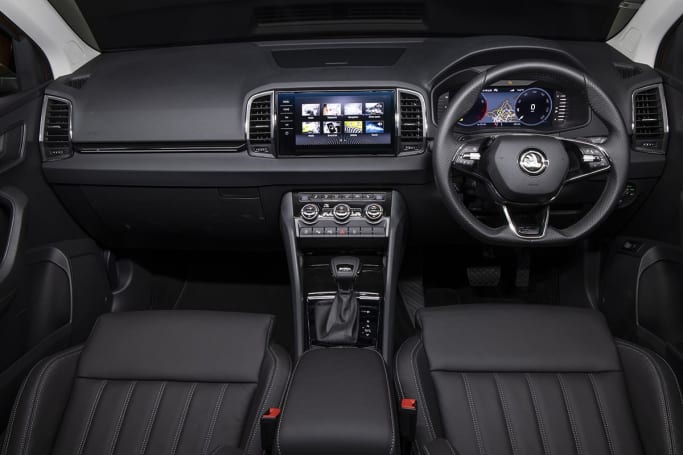
The central multimedia display is good and functions well, and all of the controls and stalks are well positioned. 'Virtual Cockpit' is one of the best digital instrument displays there is. The cabin design might not wow you, but it’s hard to fault the functionality of the Karoq.
In the second row, there’s loads of space for three, with ample toe, leg and headroom, and decent bottle storage in the doors. While the Style might lack the rear ski port and centre rear armrest of the Sportline, it has a much more useful trick up its sleeve.
It comes standard with Skoda’s 'Varioflex' rear seating, which folds 40/20/40. Each separate seat can be folded, lowered or raised, tumbled forward to greatly enhance cargo space, or removed from the car completely. It’s like Honda’s 'Magic Seats', and it’s a brilliant addition that sets it apart from its rivals - aside from Honda.
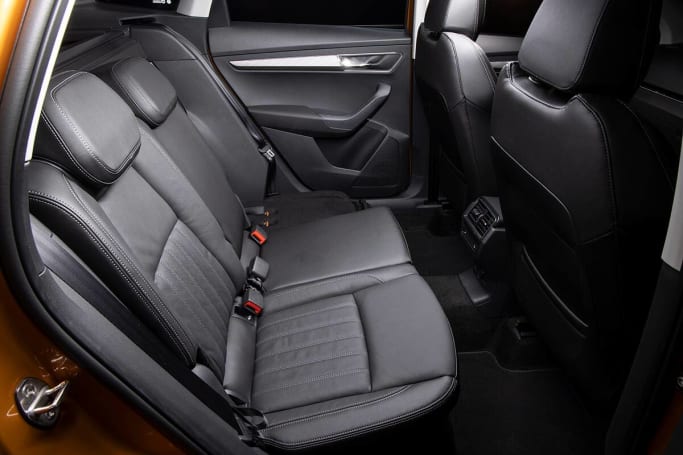
The Sportline swaps the Varioflex seats for regular sports seats that, in the rear, fold 60/40. The front seats in the Sportline offer incredible support, and the flat-bottom perforated leather steering wheel adds to the sporty vibe.
With a 588-litre boot (with all seats in place), the Karoq 110TSI Style has more space than the CX-5, Sportage, CR-V and the Toyota RAV4, but it can’t match the 615-litre capacity of its VW Tiguan sibling.
But the 140TSI Sportline has less cargo space, dropping to 521L and 1630 with rear seats folded. Both models come standard with a myriad of luggage nets and tie down hooks.
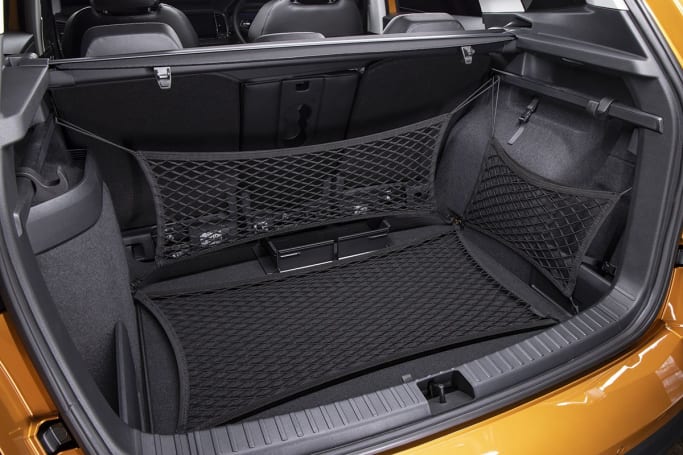
Two powertrains are on offer in the Karoq, starting with the 110TSI Style’s 1.4-litre four-cylinder turbocharged petrol engine, driving the front wheels via an eight-speed torque-convertor automatic transmission.
This is the same powertrain found in many a VW Group product, including entry-level versions of the Golf, and it pumps out 110kW at 6000rpm and 250Nm at 1500-3500rpm. Skoda says it can cover 0-100km/h in 9.2 seconds.
Under the bonnet of the 140TSI Sportline 4x4 is a 2.0-litre four-cylinder turbocharged petrol engine, delivering 140kW at 6000rpm and 320Nm at 1500-4100rpm, paired with a seven-speed dual-clutch automatic transmission and all-wheel drive.
A version of that engine is found in the Tiguan and the Golf GTI. The Sportline can do 0-100km/h in seven seconds. It also gains a multi-link rear suspension set-up for sportier handling.
Fuel consumption in the 110TSI Style is rated at 6.5 litres per 100 kilometres on the combined cycle, and it emits 147g/km of CO2. It has a 50-litre fuel tank.
The 140TSI Sportline consumes 6.6L/100km of fuel and emits 152g/km of CO2. It has a larger 55-litre fuel tank. Both Karoq grades require a minimum 95 RON premium fuel.
The Karoq was tested by crash safety authority ANCAP back in 2017 and was awarded a maximum five-star rating.
Given the Karoq’s age, it is not fitted with a front centre airbag to help avoid injury between the driver and passenger in a side impact.
Standard safety gear on the 110TSI Style includes adaptive cruise control, front and rear parking sensors, auto emergency braking with pedestrian detection, manoeuvre braking assist, multi-collision braking, seven airbags, a tyre pressure monitoring system and driver fatigue detection.
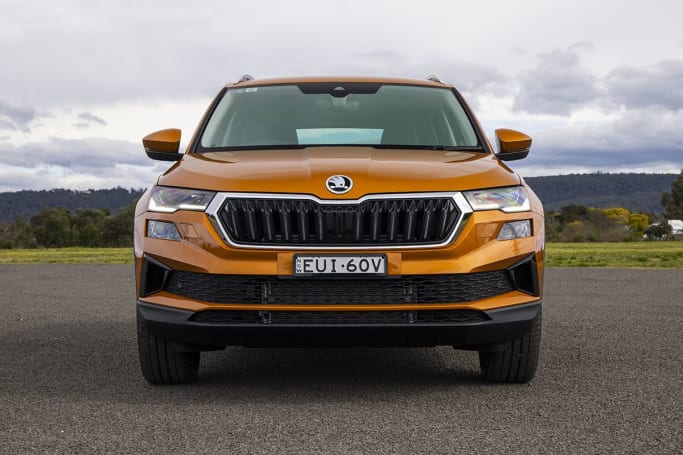
Unfortunately items like lane keeping aid, traffic jam assist, rear cross-traffic alert and blind spot monitor are only available as part of an options pack or as individual options. In the 110TSI Style the latter two aren’t available, even as options.
Given the standard safety gear offered on most, if not all, variants of more affordable medium-SUV alternatives like the aforementioned Sportage and Tucson, it’s odd these features are not standard at this price point.
Basic Warranty
7 years / unlimited km warranty
ANCAP Safety Rating

The Karoq comes with a five-year, unlimited kilometre warranty.
The servicing schedule is every 12 months or 15,000 kilometres, whichever occurs first, which average for the class.
Capped-price servicing packs for the Karoq cost $1500 for five years, or $2100 for seven years, both averaging $300 per service, which is pretty good.
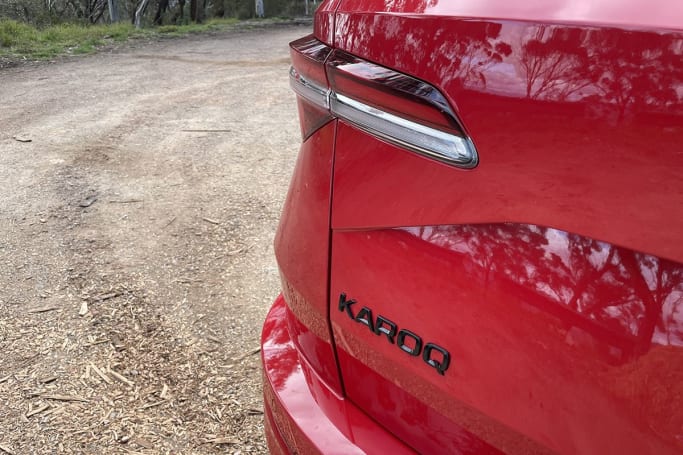
Skoda has also just launched service and maintenance subscription plans that allow owners to pay a monthly fee to cover servicing and some parts costs.
Skodas are covered by an initial one year of free roadside assist, but if you continue servicing your Karoq with a Skoda dealer, it will be topped up by a year for a maximum of nine years.
The two Karoq variants have quite different driving characteristics and will likely appeal to different buyers.
On the road, the 110TSI Style is competent, acceleration is adequate but it will not set any hearts racing. The 1.4-litre engine is rowdy when pushed, particularly up hills, but remains composed around town.
The ride is firm and you will feel and hear potholes and large ruts in the cabin. It lacks the supple ride of a RAV4.
The Sportline ups the fun factor considerably, with the punchy 2.0-litre turbo and seven-speed dual-clutch combo ensuring smooth yet engaging acceleration and performance.
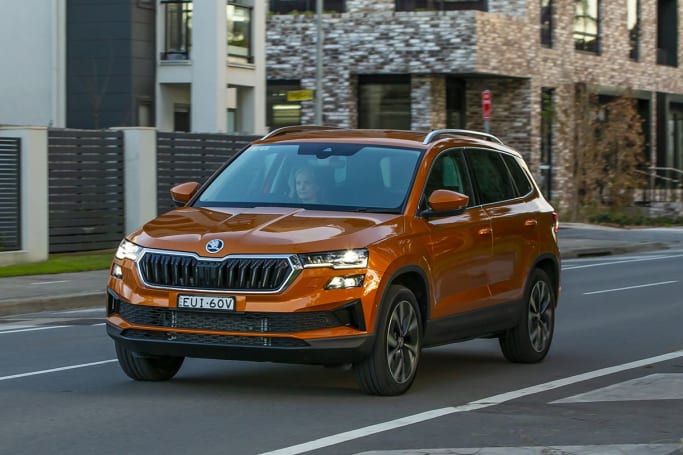
When it comes to dynamic driving, the Karoq Sportline shines, proving that it’s more than just a family hauler - it’s a warmed up SUV that would give a few hot hatches a run for their money.
And that becomes clear the second you hit a twisty section of road. The Sportline handles like a much smaller car and gives the Karoq yet another selling point that many of its rivals can’t match - genuinely engaging dynamics.
But the compromise here is, again, the ride quality. The suspension has an even firmer setting than in the 110TSI Style, unsurprising given the performance bent. But those road corrugations will make themselves known.
Ultimately, however, it’s something you can get used to. I spent a few months with a pre-facelifted Karoq Sportline in 2020, and found the ride quality around town more than fine for day-to-day driving.
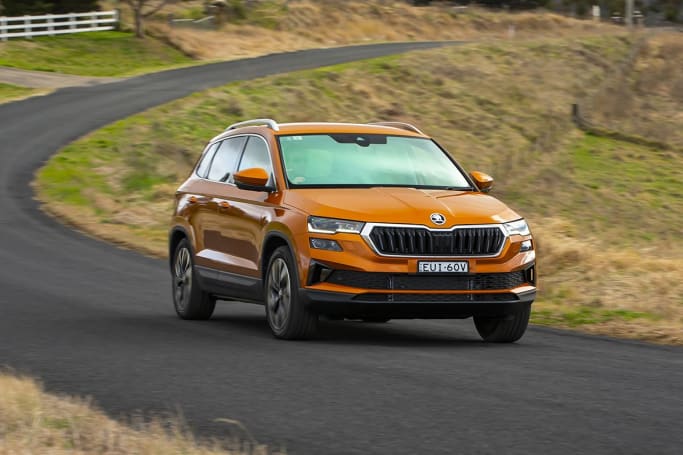
This update hasn’t exactly transformed the Karoq, but arguably, it didn’t need that much of a change to begin with.
The two Karoq grades should appeal to very different buyers. The flexibility, packaging and space of the 110TSI give it ammunition against regular medium SUV rivals, while the 140TSI Sportline offers ripping performance in a more visually appealing package - it just lacks some of the practicality of the Style.
Either way, the Karoq deserves way more attention than it’s been given in Australia since its 2018 launch. This update goes some way to fixing that - as long as Skoda can sort out its supply issues.
Note: CarsGuide attended this event as a guest of the manufacturer, with travel, accommodation and meals provided.
| Vehicle | Specs | Price* | |
|---|---|---|---|
| Style 110TSI | 1.4L, —, 8 SP AUTO | $38,390 – 45,210 | 2023 Skoda Karoq 2023 Style 110TSI Pricing and Specs |
| Sportline (4X4) 140TSI | 2.0L, —, 7 SP AUTO | $44,880 – 52,140 | 2023 Skoda Karoq 2023 Sportline (4X4) 140TSI Pricing and Specs |
| Price and features | 7 |
|---|---|
| Design | 7 |
| Practicality | 9 |
| Under the bonnet | 8 |
| Efficiency | 8 |
| Safety | 6 |
| Ownership | 7 |
| Driving | 8 |
$30,900
Lowest price, based on 102 car listings in the last 6 months